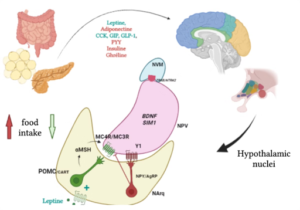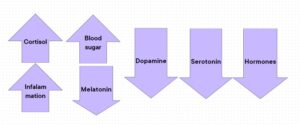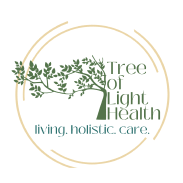At Tree of Light Health, we are all about the light! In essence, we are beings of light. Ultimately, light, energy, and frequency are key for healing (not necessarily medicines, IVs, or supplements). And you do not have to go very far to experience it. And it is also free and accessible right now 🙂
But, there is more to the story of course. Bluelight toxicity (your cell phone, computer, etc.) plays a big role in circadian rhythm disruptions, leading to low dopamine, high cortisol, weight gain etc.
Simply put: synching your biology with natural light (and reducing blue light toxicity) has many beneficial quantum biological effects, including, weight loss, increased energy, less brain fog, improved focus, lessened depression and anxiety, improved sleep, improved hormonal function, and many other functions.
I have found for myself at least, that if I understand the way something works, I will be more prone to use it in my daily practice 🙂 You may have heard of things like Vitamin D and Melatonin, but you may not have been aware that these are hormones with very powerful effects on the body. And what influences their production the most? Well, you guessed it… Sunlight in the form of UV and infrared light 🙂 Sunlight, in turn, turns on a whole symphony of goodness…
To truly grasp the cocktail of biochemical brilliance that ties melatonin, melanin, POMC, vitamin D, and neurotransmitters into a cohesive narrative, let’s embark on an enlightening journey. Picture Anthony Bourdain, but instead of critiquing street food in Bangkok, we’re dissecting the interplay of sunlight, circadian rhythms, and our internal workings. Grab a drink and let’s get started.
Melanin, POMC, and Sunlight: The Biochemical Happy Hour
Melanin Production: Melanin is simply the pigment that gives you a tan. However, Melanin is the James Bond of pigments—smooth, protective, and always in action. Produced by melanocytes, these little agents are on a mission triggered by sunlight, particularly UV radiation. Think of UVB as the party starter that slightly burns your skin but gets the crowd (keratinocytes) going:
- UV Radiation and Keratinocytes: UVB radiation hits your skin, making keratinocytes scream like they’ve seen a ghost, sending out distress signals.
- Activation of Melanocytes: These signals are like a bat signal for melanocytes, prompting them to crank out melanin.
- Melanin Synthesis: Tyrosine, our versatile amino acid, goes through a multi-step makeover, catalyzed by tyrosinase, turning into the suave eumelanin (brown/black) or the flamboyant pheomelanin (red/yellow).
Proopiomelanocortin (POMC): Now, POMC is like the unsung hero behind the scenes, a precursor polypeptide undergoing a rigorous bootcamp to produce melanocyte-stimulating hormones (MSH)*, adrenocorticotropic hormone (ACTH), and β-endorphin. These peptides have roles ranging from pigmentation to making you feel like you’ve just had a pint of your favorite beer.
Heads up: Many of you have heard of melanocyte-stimulating hormone (MSH) which we measure in CIRS or chronic inflammatory response syndrome. In essence, if your MSH is low, you tend to be inflamed, have sleep issues potentially weight and hormone issues. It can be a long process of detoxing things like biotoxins to get your MSH out. But guess what? How about adding a little sunlight and infrared to your life? This will naturally boost your MSH over time and accelerate the healing CIRS healing process..
Sunlight, POMC, and Vitamin D: Sunlight, our celestial bartender, serves up vitamin D cocktails through UVB radiation. It’s like getting a suntan and a health shot in one go. The process is a bit complex but worth it:
- UVB converts 7-dehydrocholesterol in your skin into previtamin D3, which then becomes vitamin D3 (cholecalciferol). This vitamin D gets jazzed up in the liver and kidneys to its active form, calcitriol, regulating calcium and phosphate metabolism and offering more benefits than a top-shelf whisky.
It is much better to get your vitamin D from sunlight. This creates a sulfated form of cholesterol that has many beneficial effects on the body. Remember: All hormones are made from cholesterol and, if your cholesterol is sulfated it acts more like an antioxidant and an electron carrier. Now: Whether or not to supplement vitamin D or not? That is the million-dollar question and I will address that in my upcoming webinar, so stay tuned!
Circadian Rhythms and Neurotransmitters: The Symphony of the Night
Melatonin and Circadian Rhythms: Melatonin is your internal bartender, serving up a nightly special to help you wind down. Produced by the pineal gland when the lights go out, it’s essential for syncing your body’s internal clock with the external world. But beware, the blue light from your screens is like a bad DJ, killing the vibe and suppressing melatonin production, leaving your circadian rhythms in disarray.
Neurotransmitters:
Sunlight doesn’t just give you a tan; it’s also behind the scenes, mixing neurotransmitter cocktails. Serotonin, dopamine, and norepinephrine are like the life of the party, ensuring you feel good, think straight, and keep dancing through life. Serotonin, a precursor to melatonin, is whipped up from tryptophan and needs light exposure to keep the bar stocked.
Key point: When your eyes see the sunrise, this turns on a compounding pharmacy of goodness. Why not start your day off right?
Melanocortin Pathway and Mitochondrial Function: The VIP Lounge

Melanocortin Pathway: The melanocortin pathway is like the VIP section in your body’s nightclub, where POMC-derived peptides bind to melanocortin receptors (MCRs). These receptors are involved in top-tier physiological processes, from energy homeostasis to inflammation control. Messing with this pathway is like spiking the punch—things can go downhill quickly, affecting mitochondrial function and energy metabolism.
Mitochondrial Function: POMC peptides, especially ACTH, influence adrenal function, acting like bouncers at the door, regulating stress responses and keeping mitochondria—the powerhouse of the cell—buzzing. Melanin, with its free radical scavenging prowess, is like the security detail, protecting mitochondria from oxidative stress.
Diseases Related to Melanin, POMC, and Vitamin D Deficiency: When the Party Goes Wrong
Unfortunately, there are a slew of things that can go wrong when you do not get enough sunlight, and, since most of us spend the majority of our time indoors, this can lead to dysfunction of all kinds:
Neurodegenerative Diseases:
- Autism, Alzheimer’s, Multiple Sclerosis, and Parkinson’s Disease: Imagine these conditions as the aftermath of a bad party—mitochondrial dysfunction, oxidative stress, and neuroinflammation are rampant. Low melanin, POMC activity, and vitamin D are like running out of good drinks early, leading to chaos. Vitamin D is your neuroprotective bouncer, keeping things in check.
Autoimmune and Endocrine Disorders:
- Hypothyroidism and Autoimmune Diseases: POMC-derived peptides and vitamin D are crucial for immune regulation. Deficiencies are like inviting troublemakers to the party, leading to dysregulated immune responses and conditions like hypothyroidism and autoimmune diseases.
Cancer:
- Vitamin D and Cancer: Low vitamin D levels are a red flag for increased cancer risk. Vitamin D influences cell behavior like a good party host—ensuring proper proliferation, differentiation, and apoptosis. Deficiency can lead to a wild, uncontrollable scene, promoting carcinogenesis. Studies, like those in the International Journal of Cancer, show low vitamin D is linked to various cancers.
Impact of Blue Light Exposure: The Uninvited Guest
Blue Light and Melatonin: Blue light from devices is the party crasher, suppressing melatonin by inhibiting the enzyme arylalkylamine N-acetyltransferase (AANAT) in the pineal gland. This disruption is like a bad DJ set, leading to circadian rhythm disorders and affecting your sleep and health.
Effects on Melanin and POMC:
- Melanin: While blue light’s main gig is messing with melatonin, chronic exposure can also affect skin health and melanin production indirectly, through disrupted circadian rhythms and hormonal imbalances.
- POMC: Disruption of circadian rhythms can mess with the hypothalamic-pituitary-adrenal (HPA) axis and POMC processing, leading to imbalances in energy homeostasis, immune function, and stress responses.

Conclusion
Understanding the complex interplay between melatonin, melanin, POMC, vitamin D, and neurotransmitters is like mastering the art of throwing a perfect party. Modern lifestyle factors, such as inadequate sunlight exposure and excessive blue light from screens, are the uninvited guests that can disrupt these pathways, leading to various health issues. Addressing these disruptions through lifestyle modifications—like increasing natural light exposure and reducing screen time—can help keep the party going smoothly and mitigate adverse effects.
Please reach out to us for our FREE GUIDE to circadian rhythm support!
References
- Holick, M. F. (2007). Vitamin D deficiency. New England Journal of Medicine, 357(3), 266-281.
- Gupta, R., & Chan, W. H. (2013). Blue light therapy. Translational Biomedicine, 4(2), 2.
- Holick, M. F. (2006). High prevalence of vitamin D inadequacy and implications for health. Mayo Clinic Proceedings, 81(3), 353-373.
- Harms, M. J., & Thummel, C. S. (2012). Circadian rhythms in metabolism. Science, 338(6104), 198-202.
- Molitch, M. E. (2012). Pathophysiology and treatment of prolactinomas. New England Journal of Medicine, 369(21), 2012-2020.


